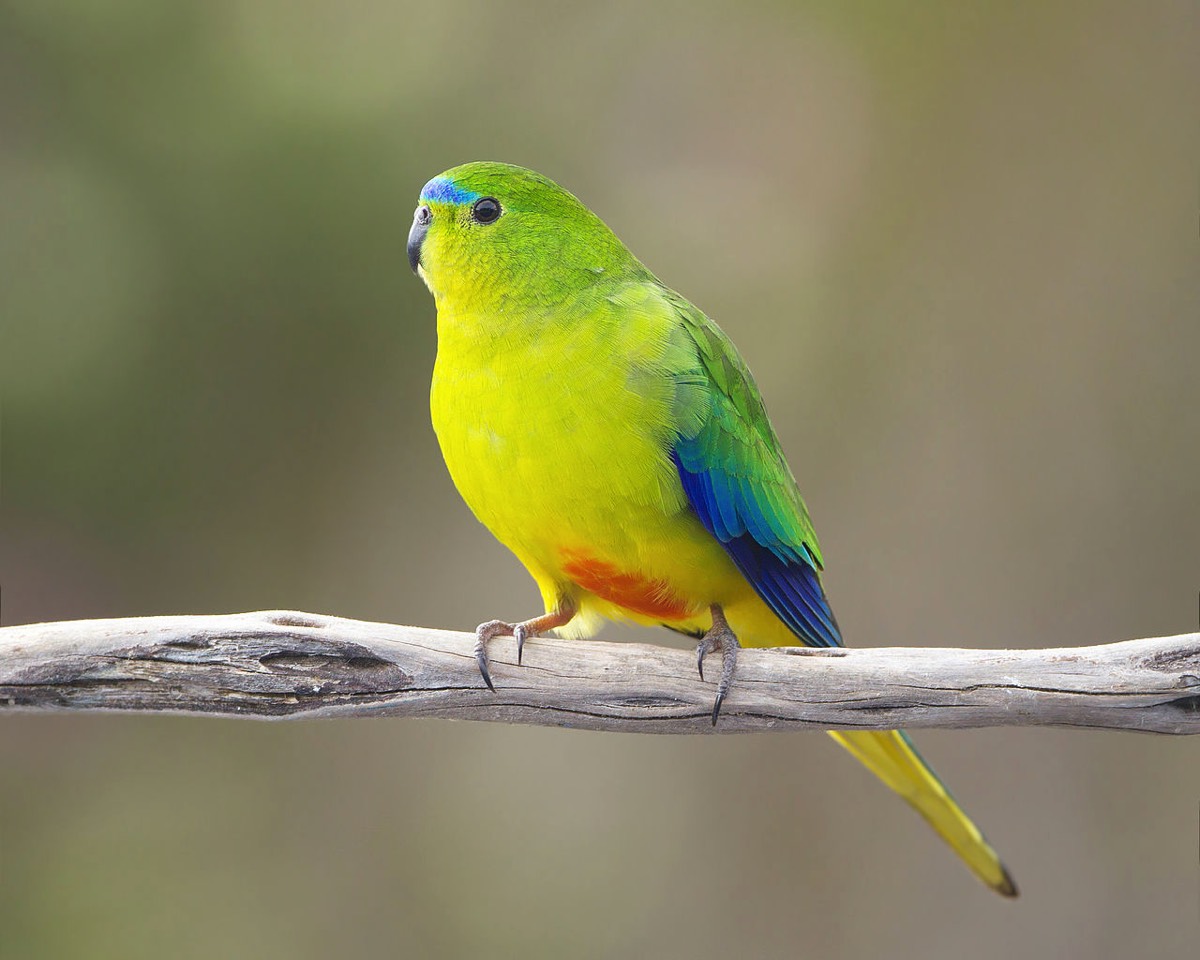Orange Bellied Parrot - Neophema Chrysogaster - Critically Endangered
The orange-bellied parrot (Neophema chrysogaster) is a small parrot endemic to southern Australia, and one of only three species of parrot that migrate. It was described by John Latham in 1790. A small parrot around 20 cm (8 in) long, it exhibits sexual dimorphism. The adult male is distinguished by its bright grass-green upper parts, yellow underparts and orange belly patch. The adult female and juvenile are duller green in color. All birds have a prominent two-toned blue frontal band and blue outer wing feathers.
The orange-bellied parrot breeds in Tasmania and winters near the coast, foraging on salt marsh species, beach or dune plants and a variety of exotic weed species[2] on southern mainland Australia. The diet consists of seeds and berries of small coastal grasses and shrubs. With a wild population of 14 birds as of early February 2017, it is regarded as a critically endangered species. The orange-bellied parrot is rated as critically endangered on the International Union for Conservation of Nature (IUCN)'s Red List of Endangered species.
Orange-bellied parrots are being bred in a captive breeding program with parrots in Taroona, Tasmania, Healesville Sanctuary, Adelaide Zoo, Moonlit Sanctuary Wildlife Conservation Park and Priam Parrot Breeding Centre. The captive population consists of around 300 birds, with a target of 350 birds by 2016–17. Because of the decline in the wild population in recent years, an additional 21 birds from the wild population were captured in 2010–2011 to improve the genetic diversity of the species' captive breeding program. Taken as a whole, the captive population, an example of ex situ conservation, is termed an "insurance population" against extinction.
Description: The orange-bellied parrot is a small parrot around 20 cm (8 in) long; the adult male has bright green head, neck and upperparts, and yellow-green breast, abdomen and flanks. The feathers of the cheeks, neck and underparts are yellow-green with lime green tips and fringes, and hence appear more bright green when the bird has just moulted and more yellowish as the plumage wears. Feathers on the crown are bright green with darker green tips. It has a prominent, two-toned blue frontal band, with a lighter blue border both above and below the horizontal dark blue band. On the belly is an oval patch of orange around 2 cm in diameter. The undertail coverts are yellow to pale yellow. The uppertail is green-blue with yellow sides. The under wing-coverts and flight feathers are dark blue, with paler blue median wing-coverts. The upper mandible of the bill is blackish grey with a greyish, orange-brown or salmon-coloured base and cutting edge, while the lower mandible a brownish orange a grey-black tip. The cere is blackish grey with a pale brown tinge around the nostrils, the orbital eye-ring is light grey and the iris is dark brown. The legs and feet are dark grey with a red tinge between scales. The adult female has slightly duller shades of green plumage overall, with a paler blue frontal band. Its orange belly patch is about 30% smaller and less distinct. Moulting takes place in late winter and early spring.
The juvenile is a duller green to yellow-olive colour overall, with a much less prominent blue frontal band above the eyes. It has a dull yellowish or orange bill, which darkens to brown by the time the bird is three months old.
The orange-bellied parrot most commonly utters a single-note buzzing sound that is repeated every one to three seconds as a contact call. This is generally made orange-bellied parrots while flying, but also by birds seeing others in flight. The alarm call is a quickly repeated tzeet that has a buzzing quality. Individuals may make this call when flushed from cover. The gurgle-buzz call is made by birds acting as sentries at feeding areas, and is a mixture of an alarm call interspersed with chattering and hissing. When feeding, orange-bellied parrots may make soft low-pitched chitting sounds.
The blue-winged and elegant parrots can be mistaken for the orange-bellied parrot, however their tinkling alarm calls and lighter olive-green upper parts distinguish them. Their blue frontal bands have only light blue border on one side.
Distribution and Habitat: One of three migratory parrot species, the orange-bellied parrot breeds solely in South West Tasmania, it nests in eucalypts bordering on button grass moors. The entire population migrates over Bass Strait to spend the winter on the coast of south-eastern Australia. On the way, they may stop (and occasionally overwinter on) King Island, particularly Lake Flannigan. The few mainland sites contain their favoured salt marsh habitat, and includes sites in or close to Port Phillip such as Werribee Sewage Farm, the Spit Nature Conservation Reserve, the shores of Swan Bay, Swan Island, Lake Connewarre State Wildlife Reserve, Lake Victoria and Mud Islands, as well as French Island in Western Port.
In late 2017, there was a possible sighting at Canunda National Park in South Australia; the most recent confirmed sighting in the state being five years beforehand at Port MacDonnell.
Breeding: In the wild, the orange-bellied parrot tends to be monogamous, though a bird will seek a new mate if its old one has died. However, males can mate with multiple females in captivity. Pairs can form on the mainland before migration or after arrival in Tasmania. The orange-bellied parrot is capable of breeding in its first year of life. The oldest known individual in the wild is known as blue/black F. At over nine years old, it is thought to have made 20 trips across Bass Strait.
Breeding is restricted to southwestern Tasmania, generally within 20 km (12 mi) of Melaleuca. The breeding season is November to February, with birds arriving at Melaleuca in early October, after which time they begin looking for suitable sites for nesting.[24] They nest in hollows in mature trees—usually Smithton peppermint (Eucalyptus nitida) or sometimes swamp gum (E. ovata). The entrance is a 6–10 cm (2 1⁄2–4 in) wide hole in a broken branch or trunk, the hollow itself being up to 60 cm (24 in) deep. Since 1991, nest boxes have been built to increase the number of suitable nest sites. The female cleans out the hollow and lays the almost round white eggs on a layer of rotten wood.The clutch consists of 3 to 6 (average 4.5) eggs measuring 21.6 mm x 18.1 mm, with the eggs being laid at two day intervals. A pair will re-use a successful nesting site, with the some sites used for up to six years. The female commonly remains in the nest for several days before laying.
The female incubates the eggs for 21–24 days.[24] During this time, the male forages up to 3 km (1.9 mi) from the site. The eggs hatch 1–2 days apart, and the young are nidicolous and semi-altricial—that is, they are born helpless and blind and remain in the nest for an extended period. They are initially covered in off-white down. The female remains on the nest for another 10 days, still fed by the male, after which time they both feed the young. By two weeks of age, larger nestlings come to the mouth of the hollow to be fed. The young fledge at 4–5 weeks old.
Feeding: The orange-bellied parrot is found in pairs or small flocks, and generally remain on the ground or in low foliage searching for food. They alternate between feeding and resting quietly, beginning just before or after dawn and resting mid-morning. In the breeding season, males feed and forage constantly to supply their mates with food while incubating, and both parents do so to feed their young. Early in the breeding season, they prefer areas that were burnt 7 to 15 years previously, while by mid-breeding season, they seek out areas that are 3 to 5 years post fire.

Psittaciformes, The Parrot Index, a part of Phoenix Feathers © 2016 - 2023
Page last updated: 12/24/23
Phoenix Feathers

